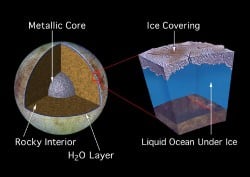All the worlds may be ours except Europa but that only makes the ice-covered moon of Jupiter all the more intriguing. Beneath Europa's thin crust of ice lies a tantalizing global ocean of liquid water somewhere in the neighborhood of 100 kilometers deep—which adds up to
more liquid water
than is on the entire surface of the Earth. Liquid water plus a heat source(s) to keep it liquid plus the
organic compounds
necessary for life and...well, you know where the thought process naturally
goes from there.
And now it turns out Europa may have even more of a heat source than we thought. Yes, a big component of Europa's water-liquefying warmth comes from tidal stresses enacted by the massive gravity of Jupiter as well as from the other large Galilean moons. But exactly how much heat is created within the moon's icy crust as it flexes has so far only been loosely estimated. Now, researchers from Brown University in Providence, RI and Columbia University in New York City have modeled how friction creates heat within ice under stress, and the results were surprising.
Although 3,100-km-wide Europa is coated in ice and technically has the smoothest surface in the Solar System, it's far from featureless. Its frozen crust features enormous regions of broken "
chaos terrain
" and is covered in long, crisscrossing fractures filled with reddish-brown material (
which may be a form of sea salt
), as well as crumpled, mountain-like ridges that appear curiously fresh.
These ridges are thought to be a result of a
form of tectonics
, except not with plates of rock like on Earth but rather shifting slabs of frozen water. But where the energy needed to drive that process is coming from—and what happens to all the frictional heat created during it—isn't well known.
"People have been using simple mechanical models to describe the ice," said geophysicist Christine McCarthy, Lamont Assistant Research Professor at Columbia University who led the research while a graduate student at Brown University. "They weren't getting the kinds of heat fluxes that would create these tectonics. So we ran some experiments to try to understand this process better."
[caption id="attachment_122594" align="alignright" width="363"]
Artist's impression of Europa's interior, based on data obtained by Galileo space probes
[/caption]
By mechanically subjecting ice samples to various forms of pressure and stress, similar to the conditions that would be found on Europa as it orbits Jupiter, the researchers found that most of the heat is generated within deformities in the ice, rather than between the individual grains as was previously thought. This difference means there's likely a
lot
more heat moving through Europa's ice layers, which would affect both its behavior and its thickness.
"Those physics are first order in understanding the thickness of Europa's shell," said Reid Cooper, Earth science professor and McCarthy's research partner at Brown. "In turn, the thickness of the shell relative to the bulk chemistry of the moon is important in understanding the chemistry of that ocean. And if you're looking for life, then the chemistry of the ocean is a big deal."
When it comes to Europa's icy crust there have traditionally been
two camps of thought:
the thin-icers and the thick-icers. Thin-icers estimate the moon's crust to be at most only a few kilometers thick—possibly coming very close to the surface in places, if not breaking through entirely—while those in the thick-ice camp think it could be tens of times thicker. While there are
data
to support both hypotheses, it remains to be seen which these new findings will best support.
Luckily we won't have to wait terribly long to find out how thick the moon's icy crust
really
is. A
recently-approved NASA mission
will launch to Europa in the 2020s to explore its surface, interior composition, and potential habitability. The mission may (i.e.,
should
) also include a lander, although of what fashion has
yet to be determined.
But when the data from that mission do finally come in, many of our long-standing questions about this mystifying icy world will finally be answered.
The team's
research
is published in the June 1 issue of
Earth and Planetary Science Letters
.
Source: PhysOrg.com
 Universe Today
Universe Today

